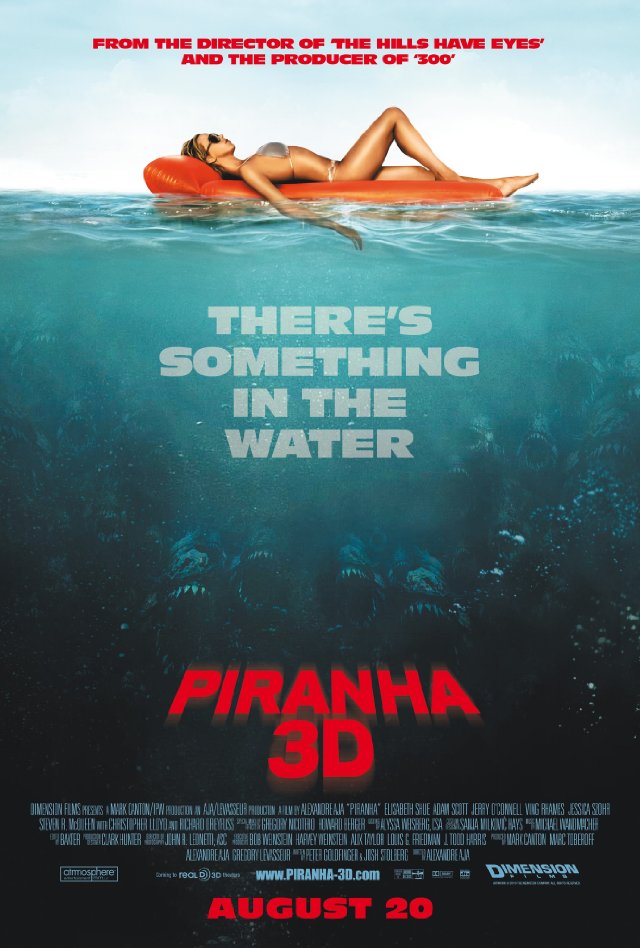Status: In theaters (opened 8/20/10)
Directed By: Alexandre Aja
Written By: Pete Goldfinger & Josh Stolberg
Cinematographer: John R. Leonetti
Starring: Elisabeth Shue, Steven R. McQueen, Jerry O’Connell, Jessica Szohr, Kelly Brook, Riley Steele, Adam Scott, Ving Rhames
Piranha 3D is one of the funniest movies I’ve seen in a while, and if you believe me when I tell you that it’s intentionally so, you’ll take that as praise and a recommendation. It’s a gleefully vapid and exploitative horror film, relishing in all of the tropes of the genre with a tongue firmly planted in its cheek throughout.
Director Alexandre Aja knows what he’s doing. He’s clearly a fan of the original 1978 Piranha, yes, but also of Jaws, the inspiration for that film, this one, and countless others. As Spielberg did so well in 1975, Aja here gives the water a life of its own, making it a character unto itself. His cinematographer, John R. Leonetti, spends a lot of time framing shots from below, or placing the camera on the surface of the water, to give us a fish-eye’s view of the soon-to-be victims. There’s a suspense that’s built rather admirably, not so much because we’re tense and nervous about what’s going to happen, but because we’re looking forward to seeing how it does.
The script isn’t so much a rip-off of Jaws as it is a send-up, an homage. We get a small town that’s invaded annually by a large influx of tourists, but here, in true exploitation-movie fashion, it’s a spring break haven on a lake in Arizona, rather than a peaceful New England hamlet. The setting couldn’t be more perfect: Lake Victoria is over-populated with college kids looking to “go wild” (in more ways than one), and they provide a veritable douchebag buffet for the titular piranhas to feast upon.
The town is presided over by Sheriff Forester, played by my long-time love Elisabeth Shue (hey, I grew up with Adventures in Babysitting). When I first saw the trailers for Piranha 3D, I found myself wondering what the hell Elisabeth Shue was doing in this movie, but having seen it, I can give you the precise answer to that question: she’s kicking ass and taking names, that’s what. I mean, Ving Rhames, as her deputy, takes a backseat—that’s how bad-ass Lis is in this movie.
 Of course, to get to that point, we have to have the semblance of a story, and what a great way to introduce an obviously ridiculous concept: Richard Dreyfuss, essentially in character as Hooper from Jaws, is the first of many victims of the prehistoric piranhas that are freed from the lake’s depths by an untimely earthquake. Aja is remarkably patient with his first act, taking the time to give us some exposition that isn’t really needed in this kind of movie except to make us impatient for the inevitable—which is to say, he builds tension by means of story, something I certainly wasn’t expecting. We meet the bad-ass female sheriff and her son, Jake (Steven R. McQueen). He’s hired by the mogul of a thinly-veiled “Girls Gone Wild” surrogate named Derrick Jones (Jerry O’Connell) to play tour guide on the lake while the “Wild Wild Girls” do their thing. Derrick has come prepared: the stars of his latest video are played by porn star Riley Steele and British model (and current Playboy cover girl) Kelly Brook. When they “go wild,” it gave me a new appreciation of the current 3D fad.
Of course, to get to that point, we have to have the semblance of a story, and what a great way to introduce an obviously ridiculous concept: Richard Dreyfuss, essentially in character as Hooper from Jaws, is the first of many victims of the prehistoric piranhas that are freed from the lake’s depths by an untimely earthquake. Aja is remarkably patient with his first act, taking the time to give us some exposition that isn’t really needed in this kind of movie except to make us impatient for the inevitable—which is to say, he builds tension by means of story, something I certainly wasn’t expecting. We meet the bad-ass female sheriff and her son, Jake (Steven R. McQueen). He’s hired by the mogul of a thinly-veiled “Girls Gone Wild” surrogate named Derrick Jones (Jerry O’Connell) to play tour guide on the lake while the “Wild Wild Girls” do their thing. Derrick has come prepared: the stars of his latest video are played by porn star Riley Steele and British model (and current Playboy cover girl) Kelly Brook. When they “go wild,” it gave me a new appreciation of the current 3D fad.
It should go without saying that Piranha 3D is a completely ridiculous movie, but what makes it so enjoyable is that it knows it. Aja has a remarkable knack for balancing the tension/startle/scare/horrify cycle that’s common in slasher-style movies like this with not only a winking knowledge that the whole thing is ludicrous, but also a reverential appreciation of his movie’s more serious predecessors. There’s a great bit where we get the piranhas’ viewpoint from below the surface of the water as they seemingly take their time selecting their victims out of hundreds of possibilities, and then we focus on a girl’s ass hanging through the center of an inner-tube; the results are predictably bloody and comedic at the same time. Or consider the film’s climax, which takes the Jaws formula and makes it its own: the heroes’ boat, firmly established as a safe harbor, springs a leak, letting the water—which we’re well-trained to identify as dangerous—in, and bringing the piranhas with it. Young Jake doesn’t have a harpoon gun, but his situation feels pretty close to that of Quint and Brody, as does his eventual solution. There are surprisingly high-brow homages like this throughout, scenes that Piranha 3D makes its own while demonstrating that it knows exactly where they come from. Of course, then on the other side of the spectrum there’s some telling breast implants that we see floating in the lake, and a dismembered, uh, member, too—I don’t think anybody would ever accuse this movie of taking itself too seriously.
Piranha 3D, as the name clearly implies, is made to be seen in 3D, and that only adds to the fun. Aside from the previously-mentioned examples of how well gratuitous female nudity lends itself to the technology, Aja also indulges in some to-be-expected instances of what I think of as the old-school kind of gimmicky 3D. Ving Rhames rips the motor off of a boat and aims it at the camera, and woah the propellers are spinning right in your face! Piranhas snap their jaws into the audience, body parts fly out of the screen, and—you get the idea. A good time is had all around. 
The cast is surprisingly well-rounded, and with the exception of the child actors who play Jake’s younger siblings, it’s across-the-board capable. Jerry O’Connell in particular really breathes life into the film with his over-the-top sleaze-ball character, and Adam Scott likewise seems to be having a lot of fun playing the gentle-yet-masculine savior who comes to the rescue. I also enjoyed Jessica Szohr as Jake’s love interest-slash-damsel in distress; she provides the stereotypical nice-pretty-girl counterpoint to the impossibly hot “Wild Wild Girls.” Christopher Lloyd even turns up as a sort of mad marine biologist, and Eli Roth provides his services as an appropriately over-the-top wet t-shirt contest host. I realize it’s probably not for everybody, but Piranha 3D had me wearing a shit-eating grin for 90 minutes straight, and really, if you know that what you’re eating is mostly shit, but it tastes good nonetheless, you might as well allow yourself to enjoy it, right?
Comments Off on Fishsploitation
In my review of Christopher Nolan’s Inception, I mentioned that I find it to be a frustrating film. Among many other reasons (which I’ll get into more below), the basic source of this frustration for me is that the movie feels like it could be more than it is (and, indeed, probably should be), but also that Nolan clearly already thinks that’s the case. He makes movies that are imbued with a permeating sense of self-importance, and for me this not only holds them back, but also serves to make clear the sense of what could have been, while also adding some unneeded (and unwanted) pretension on top.
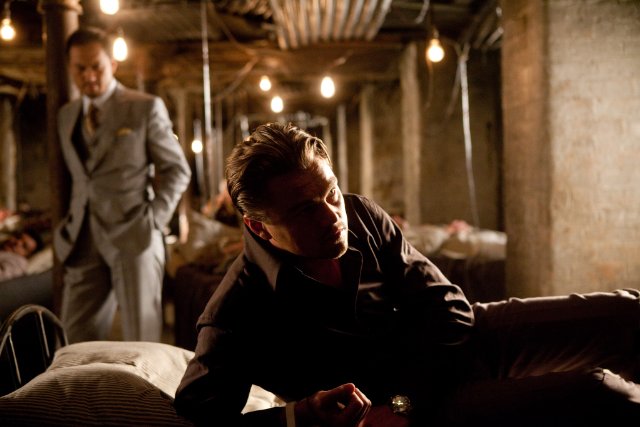 It doesn’t help that Nolan is the Internet’s darling these days, making it hard to cut through all of the hyperbole when trying to research what other people think of the movie. For instance, I went to read this review on CHUD—by a talented writer who does some of the best online movie reviews you’ll find, and for whom I have a lot of respect—but I had a hard time getting past the first sentence (I did eventually read the whole review, and it’s much more measured and well-thought-out than that first sentence initially led me to believe). I think that A.O. Scott hit it on the head when he said, “I think it used to be that ‘masterpiece’ was the last word, the end of the discussion, rather than the starting point.” But in this case, it seems, that declaration was made by many before even seeing the film in the first place.
It doesn’t help that Nolan is the Internet’s darling these days, making it hard to cut through all of the hyperbole when trying to research what other people think of the movie. For instance, I went to read this review on CHUD—by a talented writer who does some of the best online movie reviews you’ll find, and for whom I have a lot of respect—but I had a hard time getting past the first sentence (I did eventually read the whole review, and it’s much more measured and well-thought-out than that first sentence initially led me to believe). I think that A.O. Scott hit it on the head when he said, “I think it used to be that ‘masterpiece’ was the last word, the end of the discussion, rather than the starting point.” But in this case, it seems, that declaration was made by many before even seeing the film in the first place.
At any rate, there are a few issues I had with Inception—and some aspects I really appreciated—which I touched on in my review but didn’t go into in deference to my general no-spoilers rule of reviews. I’d like to take a bit of a deeper look at some of those key elements of the film here, and this time we’ll get into the details, spoilers and all.
1. Mechanics
It seems quite clear to me that Christopher Nolan is a pretty lazy and sloppy writer. He has good ideas, and they make for exciting cinema, but he’s not willing to do the work and go to the trouble of actually fleshing them all out in a totally cohesive manner. Most people seem comfortable with the mythology of Inception, and while it holds up enough to keep the movie speeding along at its non-stop breakneck pace, I think it’s pretty clear that upon a little more reflection there are some serious holes.
The film’s opening scene serves as a whirlwind introduction to the would-be science of how the dream-invasions—and the film itself—function. We learn about Extraction, the dream-stealing business in which Cobb (Leonardo DiCaprio), Arthur (Joseph Gordon-Levitt), and the rest are involved. 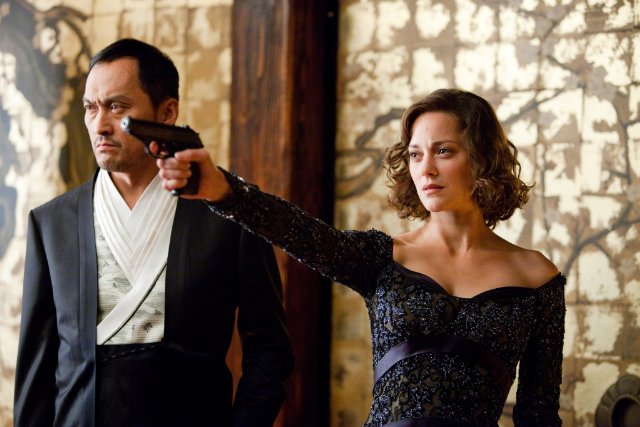 We see Mal (Marion Cotillard) early on, and it is immediately shown (rather than explained—a rare case for Nolan) that she is an uncontrollable force in the world of dreams (though we don’t yet know the specifics). We learn how Nolan’s notion of the human mind works, specifically with regards to how secrets are stored and are able to be extracted (a clever concept that, it’s been pointed out, is anything but unique). And we’re taught, by means of explanation to Saito (Ken Watanabe), of the concept of dreams-within-dreams, which of course will become quite important about an hour from now.
We see Mal (Marion Cotillard) early on, and it is immediately shown (rather than explained—a rare case for Nolan) that she is an uncontrollable force in the world of dreams (though we don’t yet know the specifics). We learn how Nolan’s notion of the human mind works, specifically with regards to how secrets are stored and are able to be extracted (a clever concept that, it’s been pointed out, is anything but unique). And we’re taught, by means of explanation to Saito (Ken Watanabe), of the concept of dreams-within-dreams, which of course will become quite important about an hour from now.
Arthur tells Saito that this initial 2nd-level dream is his, and when things get hairy, the solution is to shoot Arthur to wake him up. And yet, when that happens, the dream continues. This is but the first in what will become an annoyingly long string of incompletely-worked-out mechanics in Inception. (It’s possible that Arthur was lying when he told Saito they were in his dream, but I’m not sure what purpose that would serve.)
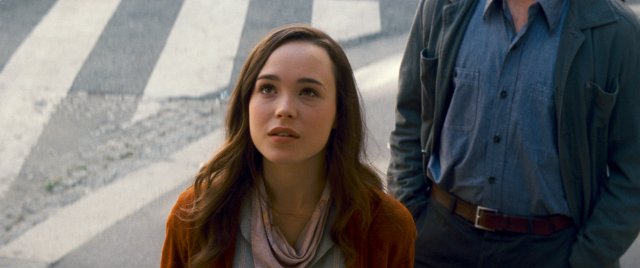 When Ariadne (Ellen Page) is brought in to replace Nash (Lukas Haas) as the dream architect for the team’s upcoming mission, it’s a cheap way for Nolan to explain how everything works to the audience. Ariadne serves to ask the questions that we want answered, but the details she gets from Cobb don’t add up very cohesively. We’re told that what the team does is to insert themselves into the subconscious of the subject, which is somehow inside the dream of a third party. None of this really makes much sense, but it’s obvious that Nolan’s intention is for us to just buy Cobb’s glossing-over explanations and go along with it. The architect’s role, in particular, seems very arbitrary; we know that the architect need not be present in the dream, because later when the mission commences Ariadne has to talk her way into going along on it. We never see how the architect’s designed dreamscape gets into the dream in the first place, except we know that the dreamer can add his or her own architectural aspects if needed, because Eames (Tom Hardy) does so in his snowy fortress-assault dream (more on this in a bit).
When Ariadne (Ellen Page) is brought in to replace Nash (Lukas Haas) as the dream architect for the team’s upcoming mission, it’s a cheap way for Nolan to explain how everything works to the audience. Ariadne serves to ask the questions that we want answered, but the details she gets from Cobb don’t add up very cohesively. We’re told that what the team does is to insert themselves into the subconscious of the subject, which is somehow inside the dream of a third party. None of this really makes much sense, but it’s obvious that Nolan’s intention is for us to just buy Cobb’s glossing-over explanations and go along with it. The architect’s role, in particular, seems very arbitrary; we know that the architect need not be present in the dream, because later when the mission commences Ariadne has to talk her way into going along on it. We never see how the architect’s designed dreamscape gets into the dream in the first place, except we know that the dreamer can add his or her own architectural aspects if needed, because Eames (Tom Hardy) does so in his snowy fortress-assault dream (more on this in a bit).
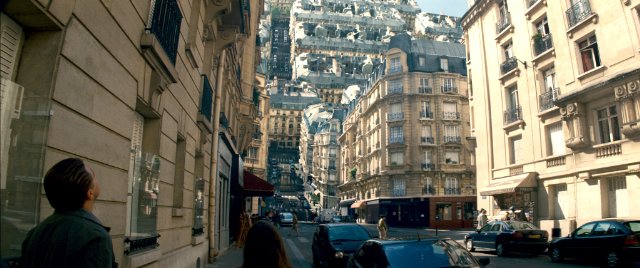 What’s most disappointing about the learning/mechanics sequence, though, is that we are shown some awesome effects that can be achieved—the exploding cafe, the folding streets, the mirrored corridor, the Penrose stairs—but rather than being a setup for even more awesome tricks to come later, these exist in the film purely for the visual thrill they provide as a way to spice up an otherwise drawn-out expository sequence. The only one of these tricks that comes up at all in the rest of the film is the Escher-like staircase effect, which Arthur uses to evade a bad guy in the hotel dream. And this further begs the question of how this all works: did Ariadne put those stairs in the hotel, for Arthur to make use of if needed, or was he able to call upon them only when the situation arose? (After the bad guy Arthur is trying to get away from falls down the stairwell, he mumbles something that was unintelligible to me in two viewings, but for all I know it might be along the lines of “Thanks, Ariadne.”)
What’s most disappointing about the learning/mechanics sequence, though, is that we are shown some awesome effects that can be achieved—the exploding cafe, the folding streets, the mirrored corridor, the Penrose stairs—but rather than being a setup for even more awesome tricks to come later, these exist in the film purely for the visual thrill they provide as a way to spice up an otherwise drawn-out expository sequence. The only one of these tricks that comes up at all in the rest of the film is the Escher-like staircase effect, which Arthur uses to evade a bad guy in the hotel dream. And this further begs the question of how this all works: did Ariadne put those stairs in the hotel, for Arthur to make use of if needed, or was he able to call upon them only when the situation arose? (After the bad guy Arthur is trying to get away from falls down the stairwell, he mumbles something that was unintelligible to me in two viewings, but for all I know it might be along the lines of “Thanks, Ariadne.”) 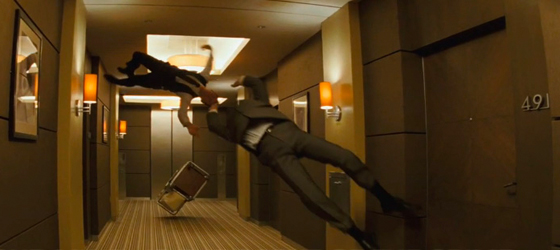 At any rate, whether the architect has put these stairs in place ahead of time or whether the dreamer can summon the effect at will, neither situation really clarifies what’s going on—if Arthur is able to control the environment of his own dream in such ways, what’s the need of the architect in the first place?
At any rate, whether the architect has put these stairs in place ahead of time or whether the dreamer can summon the effect at will, neither situation really clarifies what’s going on—if Arthur is able to control the environment of his own dream in such ways, what’s the need of the architect in the first place?
My point here is not just to point out how incompletely explained the mechanics of the film are; my point is that I feel pretty confidently that Christopher Nolan himself has not worked out these details. His film is comprised of half-developed concepts that make for exciting and “complex” cinema, but they’re not fleshed out to an extent that holds up to the kind of scrutiny a film like this almost demands. (It’s worth noting that the marketing scheme for Inception has now gone into “You need to see it more than once!” territory.) I realize that I am bothered by such things more than most, but to me a good film—especially one that is going to be deemed “a masterpiece”—needs to have this level of cohesion; it needs an air-tight script, and that is simply not the case here.
2. Characters
One of the biggest tell-tale signs of lazy writing is the fact that in an ensemble cast, there are precisely two characters with any kind of backstory or actually developed characterization whatsoever. They are Fischer (Cillian Murphy, who gives a really great performance, particularly at the film’s climax), and Cobb, whose story it is that we’ve ostensibly come to watch. The rest of the characters exist not to be representations of people, with real emotions and problems and goals, but simply to fill roles, to be types. I’ve already mentioned Ariadne, whose purpose in the movie is twofold: she asks Cobb for the explanations that we as an audience require in order to be able to follow along, and she reminds Cobb (and us)—repeatedly—of the function of Mal. 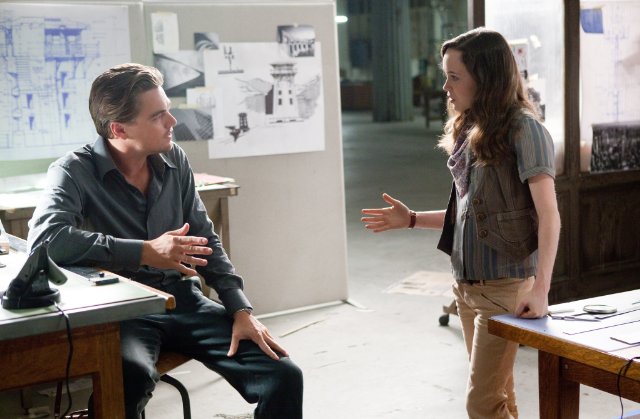 It seems to me that about 50% of her dialogue is some variation of the line, “Cobb, you can’t control Mal and we don’t know what she’ll do! She’s dangerous!” I find Ellen Page’s performance to be exceptionally dull, too; she sticks out like a sore thumb in what is otherwise a pretty solid cast as the one person who’s not putting their heart and soul into it. This is likely at least partially a result of her character’s function: she’s not really much of a character at all, she’s just there because Nolan thinks we’re all drooling, popcorn-inhaling idiots who wouldn’t be able to keep things straight without her. (And who the hell is named Ariadne, anyway? I know it’s a reference to a labyrinth-foiler from Greek mythology, but who actually gives their kid that name? It’s like Nolan just Googled some shit about labyrinths while writing the script and used the first thing he found.)
It seems to me that about 50% of her dialogue is some variation of the line, “Cobb, you can’t control Mal and we don’t know what she’ll do! She’s dangerous!” I find Ellen Page’s performance to be exceptionally dull, too; she sticks out like a sore thumb in what is otherwise a pretty solid cast as the one person who’s not putting their heart and soul into it. This is likely at least partially a result of her character’s function: she’s not really much of a character at all, she’s just there because Nolan thinks we’re all drooling, popcorn-inhaling idiots who wouldn’t be able to keep things straight without her. (And who the hell is named Ariadne, anyway? I know it’s a reference to a labyrinth-foiler from Greek mythology, but who actually gives their kid that name? It’s like Nolan just Googled some shit about labyrinths while writing the script and used the first thing he found.)
Everybody else in the cast is exclusively one-dimensional. There’s been a lot written about Inception as a metaphor for film production itself (probably the best of these that I’ve read is this one—by the same writer, Devin Faraci, who wrote the review I referenced earlier). But no matter how you look at the roles of the supporting cast, you’re not going to find much depth there. The team-building sequence in the movie is familiar from any heist flick, except that Nolan doesn’t bother telling you much of anything about who these people are; they exist to fill a role, and that’s it.  Of the supporting cast members of the dream team, I think that Tom Hardy stands out as Eames; he’s the benefactor of the movie’s lone attempts at humor. Joseph Gordon-Levitt tries too hard to be a badass as Arthur (his forced-deep voice makes it impossible for me to take his character very seriously), and poor Dileep Rao seems like he’ll spend his whole career being cast as a mystical-Eastern-guy stereotype (his Yusuf is not very unlike the character he played in Drag Me to Hell, with a little of his Avatar scientist blended in).
Of the supporting cast members of the dream team, I think that Tom Hardy stands out as Eames; he’s the benefactor of the movie’s lone attempts at humor. Joseph Gordon-Levitt tries too hard to be a badass as Arthur (his forced-deep voice makes it impossible for me to take his character very seriously), and poor Dileep Rao seems like he’ll spend his whole career being cast as a mystical-Eastern-guy stereotype (his Yusuf is not very unlike the character he played in Drag Me to Hell, with a little of his Avatar scientist blended in).
Compounding the confusion of the film—or at least adding to the amount of effort that’s required to follow it—is the inconsistent pronunciation of some of these characters’ names. Sometimes Yusuf is YOO-sef, sometimes he’s yeh-SOOF. (Arthur refers to him using the latter pronunciation at a key point in the hotel dream, and I didn’t catch what he was referring to until my second time seeing the film.) There is only one instance where I’ll excuse a movie for such sloppiness, and that’s in the Star Wars movies, where Lando pronounces “Han” and “Leia” differently than everybody else. But that’s excusable because it’s Billy Dee Williams, and who’s going to correct Billy Dee Williams?
3. Video Games
Another frequent commentary on Inception is that it feels, and plays out, like a video game movie that just so happens to not actually be based on a video game. This is usually presented as a positive, but I’m not sure why. To me, it’s a “video game movie” because it’s structured in terms of “levels,” with each getting progressively more difficult for the heroes to navigate. These levels are populated by unnamed, usually faceless foot soldiers, who are easily dispatched and only serve to slow down the progression to the level’s ultimate goal—and to keep the film dense with action scenes. There’s a good visual representation of how the levels stack here, but the one thing I’d add is that each level even features a “boss,” a character that is harder to get past than the other sentries have been, and who guards the level’s final objective.
- In level 2 (the Van Chase), after plowing through bad guys with relative ease, Yusuf must fight through a Big Black SUV that gives him more trouble on the bridge. This SUV is his last obstacle before being able to drive through the guardrail and into the water.
- In level 3 (the Hotel), there is one guard who gives Arthur more trouble than the rest. He is finally able to evade this guard by using the Penrose steps trick in a stairwell.
 In level 4 (the Snow Fortress—the most video game-like part of the film), the final boss is Mal, who shows up just before the goal has seemingly been reached. Cobb must shoot her to clear the way for Fischer to enter the vault and confront his father.
In level 4 (the Snow Fortress—the most video game-like part of the film), the final boss is Mal, who shows up just before the goal has seemingly been reached. Cobb must shoot her to clear the way for Fischer to enter the vault and confront his father.- In level 5 (Limbo), things become sort of a clusterfuck. The “boss” here is again Mal, who seems to have more power this time around—a common video game trope.
The most insightful piece I’ve read about Inception-as-video-game is Inception‘s Usability Problem, which explores the film’s exposition as a tutorial in how to watch it. I particularly enjoyed the comparison that article makes to The Matrix, an obvious inspiration for this film that serves as a telling example of how such things are handled by far better screenwriters than Nolan.
4. Performing Inception
Inception goes to great lengths to ensure that we understand the importance of the “kicks” that serve to wake the characters from the various levels of dreams. The 4-way kick sequence, from the time Yusuf drives the van off the bridge, to the time it hits the water, and everybody awakens from the multiple levels of dreams simultaneously, occupies a full 30 minutes of screen time. It’s a virtuoso example of cross-cutting and sustained tension. (Most impressive may be the fact that although the ever-falling van evokes the old cliche of a slowly-closing overhead door that seems to backtrack a bit every time we cut to it, Nolan never falls into this suspension of disbelief-killing trap.)
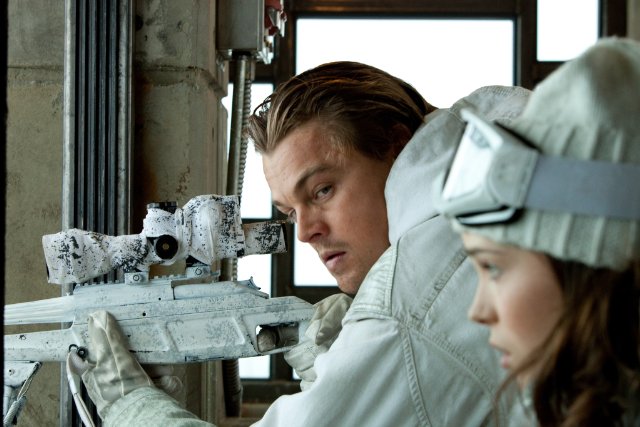 As the film races towards its climax, however, Nolan throws his own rules by the wayside. In the snow fortress level, when time becomes of the essence, a shortcut appears out of nowhere to save the day. (“Did Eames add any shortcuts?” Cobb asks Ariadne. Why, how fortunate, it just so happens that he did!) Nolan seems to have a knack for writing himself into a corner, and then pulling something out of his ass to gloss over the would-be problem and keep the action barreling forward. The worst such instance is the business with the kicks; towards the end of the half-hour-long, synchronized 4-way kick sequence, we find Cobb and Saito still down in Limbo. We know that this is a tenuous situation because Nolan has gone out of his way to warn us, over and over, about how people can get stuck “down there.” And yet, how do Cobb and Saito come out of it? It’s not shown, but we can infer that they simply shoot themselves (the last image in Limbo we see is old-Saito reaching for a gun).
As the film races towards its climax, however, Nolan throws his own rules by the wayside. In the snow fortress level, when time becomes of the essence, a shortcut appears out of nowhere to save the day. (“Did Eames add any shortcuts?” Cobb asks Ariadne. Why, how fortunate, it just so happens that he did!) Nolan seems to have a knack for writing himself into a corner, and then pulling something out of his ass to gloss over the would-be problem and keep the action barreling forward. The worst such instance is the business with the kicks; towards the end of the half-hour-long, synchronized 4-way kick sequence, we find Cobb and Saito still down in Limbo. We know that this is a tenuous situation because Nolan has gone out of his way to warn us, over and over, about how people can get stuck “down there.” And yet, how do Cobb and Saito come out of it? It’s not shown, but we can infer that they simply shoot themselves (the last image in Limbo we see is old-Saito reaching for a gun). 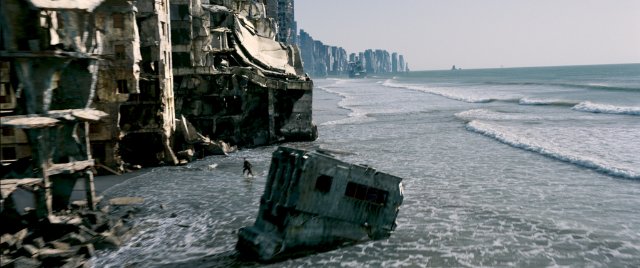 And then, we realize, come to think of it, that’s how Cobb and Mal escaped Limbo earlier, too, isn’t it? They were down there for “something like 50 years,” fearful that if they ever escaped it would be without their minds intact, and yet all it took was laying on some train tracks to wake them up.
And then, we realize, come to think of it, that’s how Cobb and Mal escaped Limbo earlier, too, isn’t it? They were down there for “something like 50 years,” fearful that if they ever escaped it would be without their minds intact, and yet all it took was laying on some train tracks to wake them up.
So while the other characters all had to jump through hoops (and, literally, perform acrobatics) to pop themselves one level at a time from limbo to the snow fortress to the hotel to the van and finally back to reality aboard the plane, Cobb and Saito are able to just skip all of that shit and wake up directly from limbo. This is convenient, because Nolan doesn’t want to lose his momentum; at this point in the movie what he’s interested in is getting you to his ambiguous ending, where you won’t find a payoff per se, but rather the food for thought that Nolan desperately wants you to emerge from the theater discussing. And again I contend that the reasons why this whole kicking thing, and the details of how Limbo works, don’t really make any sense is because Nolan himself doesn’t really understand them, either. He’s just throwing some trippy shit at you, admittedly in the name of keeping his movie exciting, but he doesn’t want to put in the effort to actually work it all out.
The much-discussed top is what Nolan is driving towards, the reason he glosses over all of these details once Fischer has had his therapeutic moment and the mission of performing Inception has been successful. Because what Nolan has done is exactly what his characters at this point have done: he’s performed Inception on you, the audience, of the same idea that Cobb was able to implant into his wife’s mind. He’s made you doubt “reality”—the reality of the film—and that is the concept he wants to leave you with. Don’t ignore the significance of the fact that Leonardo DiCaprio looks almost exactly like Christopher Nolan in this movie; he’s the director’s representation of himself onscreen, and it’s no coincidence that the director’s primary aim with his film is the same as the main character’s aim in his story. 
I think that what’s important about the film’s final image isn’t whether the top stops spinning, it’s the fact that Cobb no longer cares whether it does or not. He’s made his decision, that “this”—wherever “this” may be—is what he wants to know as Reality from now on. Whether he’s still dreaming is irrelevant; this is now his reality. He’s made a decision similar to the one that Joe Pantaliano’s character makes in The Matrix: I don’t really care anymore if this is real or not, I just know that this is what I want to believe as my own reality. The steak tastes too good to decide otherwise; the joy of seeing his children’s faces is too much to write off as not being “real.” (The concept here isn’t as complicated as many have made it out to be; it’s actually explicitly stated earlier in the film—catharsis is catharsis, regardless of whether it occurs in a dream or in one’s waking life.)
As underwritten as I find most of Inception to be, this to me is its biggest redeeming factor. After half-assing a lot of its concepts for most of its duration, in the film’s final minutes Nolan finally solidifies something of a theme, and it’s one that is worthwhile. The idea of subjective reality is one that’s fun and intriguing to explore (Nolan has done so many times before, most notably in Memento), and one that can perpetually be revisited (“Make sure you see it at least twice!”). Coming on the heels of—and tying into—the resolution of Nolan’s other theme, fatherhood, it makes for a finally-satisfying experience.
And yet, there’s still something missing here. The thesis of the film falls a little flat for me, I think due to the fact that it has gone to such lengths to reach this point, and it’s done somewhat of a sloppy job of it in the process. This doesn’t mean that I write the entire thing off, and it certainly doesn’t mean that I think you’re dumb if it does fully work for you. It’s just that it doesn’t quite resonate with me as much as I think it should, and that leaves me with an overall disappointing impression of the film. As I said in my review, Inception is a movie I enjoy—with so much action and mind-bending effects, it’s hard not to have a good time watching it—but I think it could’ve been a movie I really loved.
— —
To give credit where it’s due, most of the links above I found via Jim Emerson’s excellent Scanners blog. Jim’s done a great job collecting, excerpting, and commenting on a lot of the better writings there’ve been related to Inception. While he’s a bit harder on the movie than I am, as he says (and I totally agree), “you don’t have to particularly like a movie in order to find it worthy of analysis and discussion.” And luckily, I do like this movie; it’s the distinction between the reasons why that’s the case and those for why I don’t completely love it that make it so worthy of that analysis and discussion to me in the first place.


